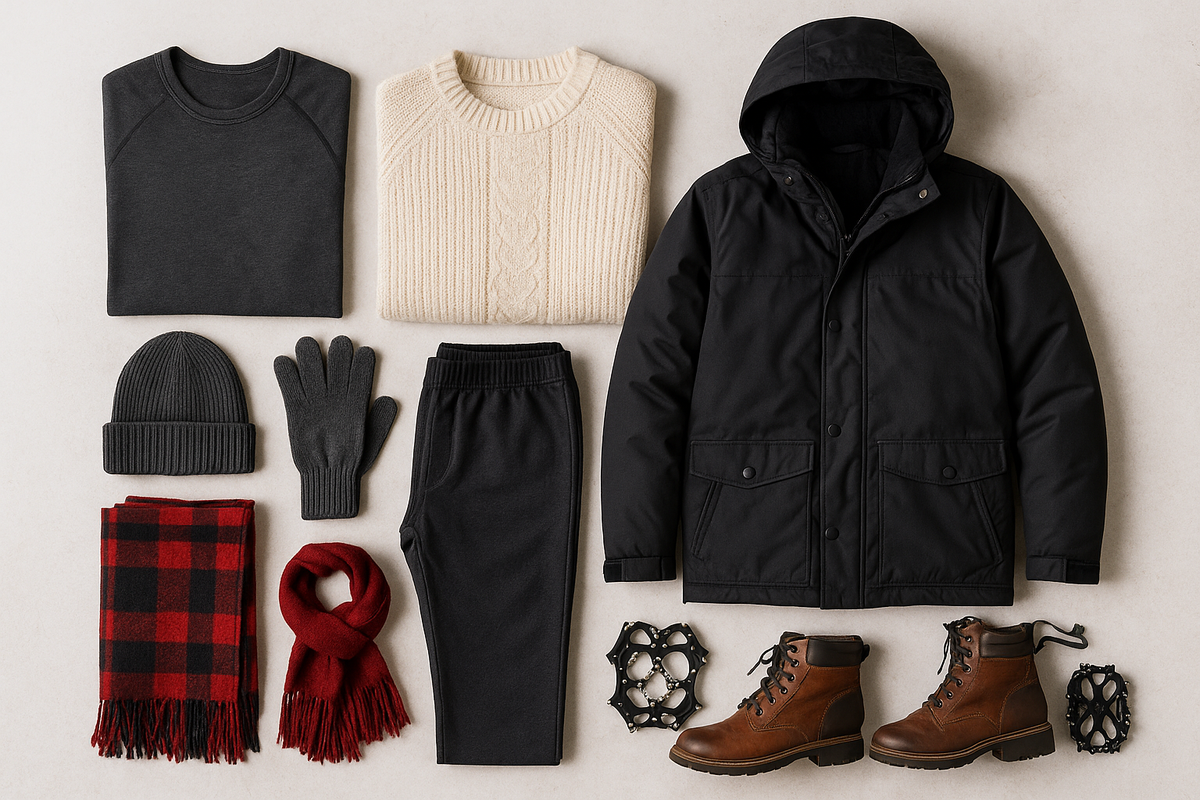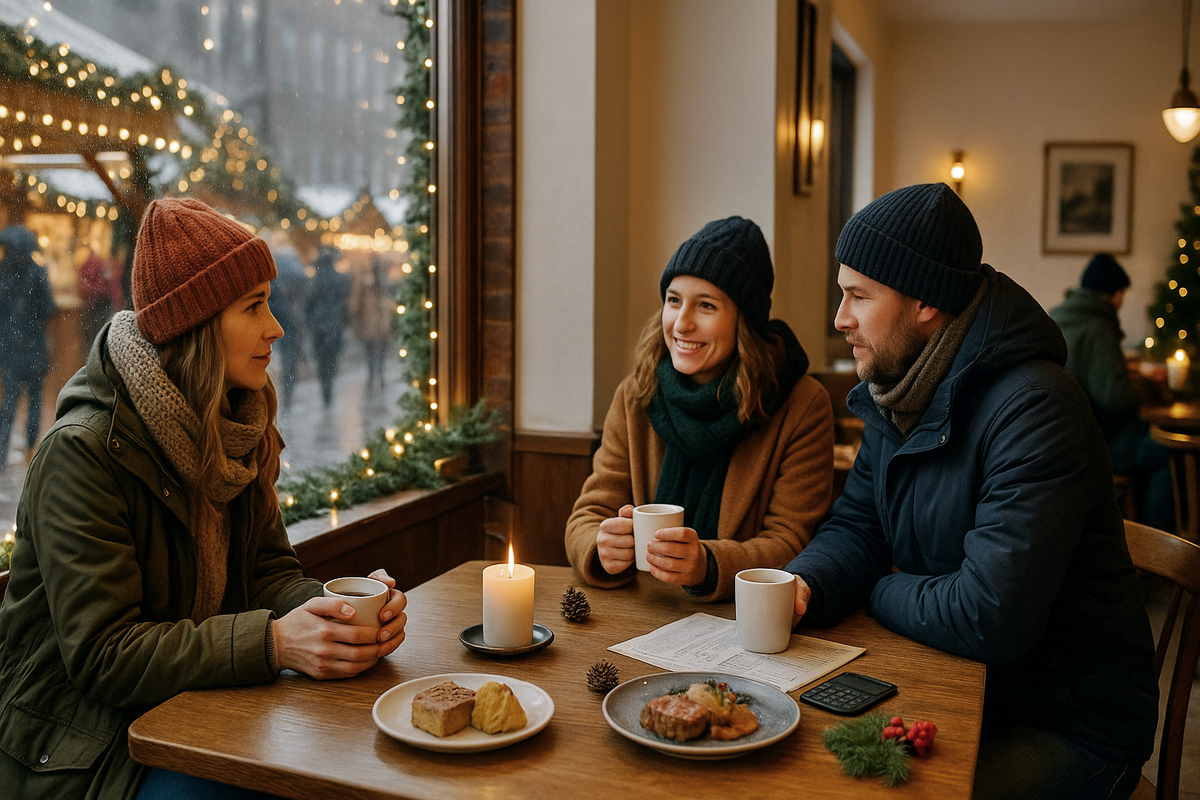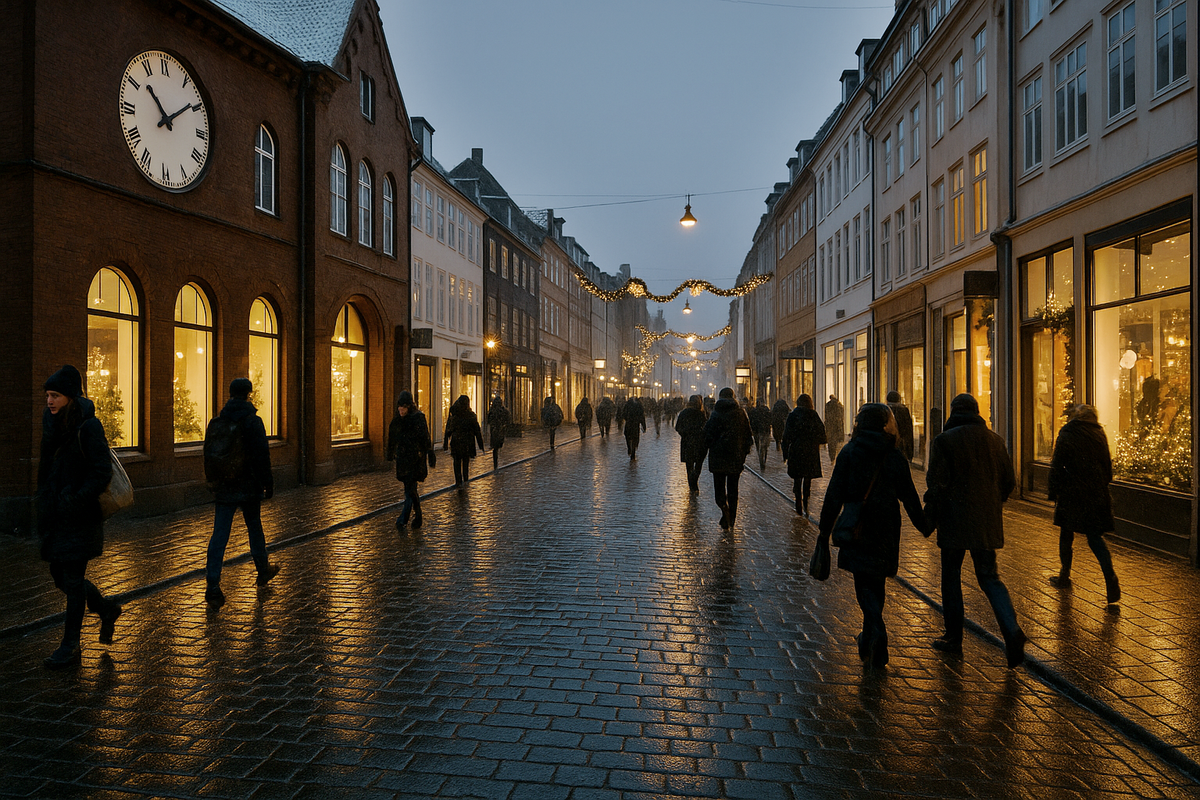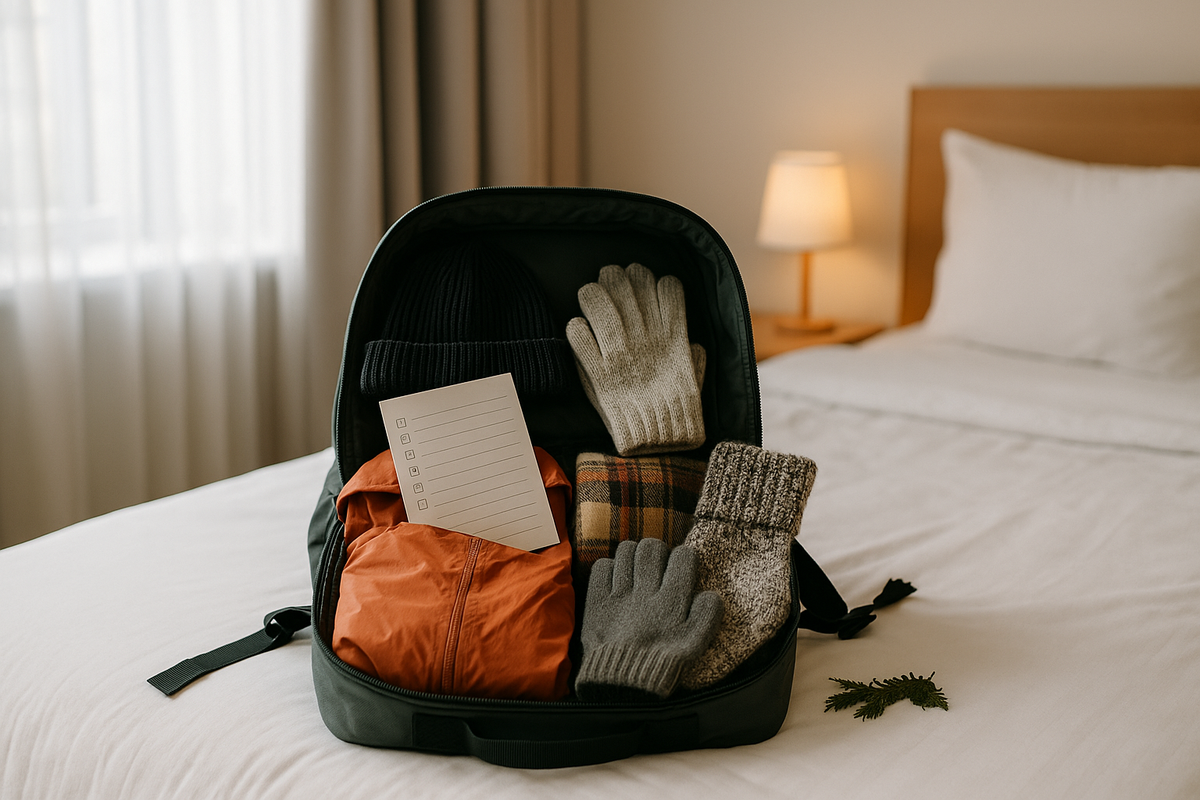🌦️ Weather realism: wind, rain, short days — clothing and warm breaks
December–January in Denmark is not a postcard with perfect snow and dry frost, but a windy, wet northern off-season. During the day, the temperature usually stays around 0...+5 °C, but the wind and dampness make it feel much colder on the embankments. 🌡️. The daylight hours are short: in Copenhagen in winter, there are only 7-8 hours of ‘working’ light, and part of that is in grey twilight. 🌫️. The purpose of this article is to take a sober look at the winter weather, provide a clear checklist of equipment, and show how to incorporate ‘warm breaks’ into your itinerary as seriously as you would sightseeing.
🌧️ Real weather in December–January: what you will encounter on site

🌡️ Wet plus, not ‘Instagram’ minus
In winter in Denmark, it is most often not ‘minus ten and sunny’, but:
- ❄️Temperature: around 0...+5 °C during the day, with a slight drop below zero possible at night.
- 🌧️Precipitation: frequent rain, drizzle, wet snow, puddles and slush underfoot.
- 🚶Surface underfoot: icy in places, wet asphalt and steps in others.
A forecast of +3 °C seems tolerable, but in reality, after 20 minutes in the wind, wearing jeans and city trainers, you will feel colder than in dry frost of −5 °C.
💨 Wind and humidity: the main ‘hidden’ problem
- In coastal cities (Copenhagen, Aarhus, Odense, seaside villages), the wind near the water increases the sensation of cold by 3–5 °C.
- Open spaces — embankments, squares, bridges, observation points — feel like a ‘cool field experiment in endurance’ in winter.
- There may be no shelter from the wind at all, so your main ally is a windproof outer layer.
🕯️ Short daylight hours: not just about ‘little sun’
In winter, it is important to plan not only ‘what to see’ but also when.
- 🌒It is light for about 7–8 hours, but morning and evening are semi-twilight.
- 📸It is better to schedule photogenic ‘postcard’ locations for midday.
- ⏰A late departure ‘at 11’ in winter automatically eats up half of the daylight hours.
Practical conclusion: winter days are shorter not only on paper — you objectively get less done with the same amount of effort.
🧥 Appropriate equipment: layers, shoes, anti-slip

In Denmark in winter, it is not those who bravely endure who win, but those who are dressed appropriately. Below is a checklist that covers markets, embankments, and queues on the street.
🧶 Layers: the basic principle of winter in Denmark
Top:
- Base layer: thin thermal underwear or a wool/wool blend jumper that wicks away moisture.
- Middle layer: a warm jumper or fleece — something that really keeps you warm.
- Outer layer: a jacket/parka with wind and moisture protection (a hoodie down jacket without a membrane is no good in rain and wind).
Bottom:
- Thick trousers (not thin jeans) + thermal trousers if necessary.
- For those who are always cold: fleece/wool leggings under trousers.
👣 Footwear: the main weak link for tourists
- Waterproofing: boots or wellies with a water-repellent upper (impregnated leather, membrane), and not textile trainers.
- Sole: non-slip, with normal tread, preferably above the ankle.
- Inside: warm insoles and wool socks; a second set in your backpack in case they get wet.
- Anti-slip: simple shoe covers/crampons — a lifesaver on ice and stairs.
🧣 Accessories that are often forgotten
- A warm hat or headband that covers your ears.
- Waterproof gloves, plus thin undergloves in case the outer ones get wet.
- A scarf or buff to cover your neck and lower face in the wind.
- A backpack with a rain cover, earmuffs/hood — additional protection from the wind.
📋 Example of a minimum set for the day
| 🧩 Item | ✅ What you should have | 👀 What to pay attention to |
|---|---|---|
| 🧥 Top layer | Base layer + sweater + wind/water protection | You should be able to add/remove a layer as needed |
| 👖 Bottom | Trousers + thermal underwear if needed | Jeans alone get wet and cold quickly |
| 👢 Footwear | Waterproof boots | Sole with good tread, not smooth |
| 🧢 Headwear | Hat/headband | Ears covered, no “decorative” holes |
| 🧤 Hands | Warm gloves | Preferably with some water protection |
| ➕ Additionally | Scarf/buff, thermos mug, spare socks | Small things that define your comfort for the whole day |
☕ Warm breaks: where and how to warm up between bonfires and fairs

Attempting to spend five hours straight outside in winter is almost guaranteed to end in hypothermia and a ruined mood. You need to plan your route in advance to include places where you can warm up.
🏠 ‘Warming points’ format
What you can use:
- ☕ Coffee shops and bakeries with normal seating.
- 🎡 Small cafes near fairs and canals.
- 🏛️ Museums, galleries, libraries, cultural centres.
- ✨ Indoor markets and food halls near the water — you can see the lights while sitting in the warmth.
- 🛍️ Shopping centres and large indoor spaces — as a backup option in case of rain/storm.
🧭 Route logic: don't be a hero
A convenient model for winter:
- 30–60 minutes outside → 20–30 minutes in the warmth.
- Each ‘block’ of the route (skating rink, fair, lights on the embankment) is immediately linked to the nearest place where you can sit down and warm up.
- Plan your evening by the water as a chain: open space → café/food hall → back outside.
👨👩👧👦 Family context
If you are travelling with children or elderly people:
- Prioritise places with toilets, seating and a children's area/corner.
- Libraries and cultural centres are often more comfortable than ‘random’ cafes with queues and noise.
🕒 Short days and ‘plan B’: how to plan your route in winter

In winter, it's not the person with the most packed itinerary who wins, but the one who leaves room for manoeuvre.
📆 Template for a day in winter weather
- Morning (8–11): Breakfast, travel, indoor activities — some museums, aquarium, exhibitions.
- Middle of the day (10–14 / 11–15): Everything that is important to see in daylight: embankments, panoramas, parks, skating rinks, ‘postcard’ views.
- Evening (after 15–16): Lights and fairs, dinner, indoor spaces, warm bars/cafes, short walks.
🌦️ Weather-dependent activities
Activities that are heavily dependent on the weather should be treated as ‘conditional’:
- Long walks along the embankments.
- Trips to open observation decks.
- Street Christmas fairs and ice rinks without shelter.
Always keep an alternative in mind: a museum, library, indoor market, shopping centre, aqua or science centre.
🌪️ Plan B for storms/heavy rain
- Have a pre-planned ‘indoor’ day: a list of 2-3 indoor attractions + 1-2 ‘backup’ places for coffee/lunch.
- Know how to get to these places by public transport from the city centre/hotel.
- Accept reality: in a storm/downpour, it is better to reconfigure your plan than to try to ‘work through’ all the items on your checklist.
✅ Mistakes to avoid and final checklist

🚫 The most common mistakes on winter trips to Denmark
- ‘The forecast is +4, so I can go without a hat and in trainers’ → wind, rain, wet shoes, urgent purchase of boots.
- Jeans and a short jacket without a layer underneath → frozen feet, early return to the hotel.
- Trying ‘not to look into cafes so as not to spend money’ → hypothermia and, in any case, unplanned expenses for a taxi and ‘anything hot’.
- No plan B for bad weather → sitting in your room and feeling like you've wasted the day.
📋 Quick checklist before going out
Before leaving the hotel/apartment:
- 🧥 Layers: are you wearing a base layer + a warm layer + a windproof outer layer?
- 👖 Legs: will your trousers stay dry in the first rain, do you have thermal trousers if necessary?
- 👢 Footwear: will your boots withstand 2-3 hours in a wet city and on steps without slipping?
- 🧣 Accessories: do you already have a hat, scarf/buff, gloves on or in your backpack?
- ☂️ Rain protection: do you have a hood, raincoat or umbrella, backpack cover?
- ☕ Warm breaks: do you know where you will warm up after 40-60 minutes of walking?
- 🏛️ Plan B: if it rains heavily or the wind picks up, do you know where to find shelter nearby?
The final conclusion is simple: clothing and route planning are your insurance policy against a ruined winter trip. If you plan ahead with layers, waterproof footwear, warm breaks and a backup ‘indoor’ day, December–January in Denmark ceases to be a lottery and becomes a conscious northern experience — with lights, fairs and comfortable walks, rather than heroic survival in the wind.
❓FAQ
✅ Temperatures around 0...+5 °C combined with wind and humidity create a ‘freezing’ cold effect, especially near water and in open areas.
✅ Use the layer principle: warm thermal underwear, a medium insulating layer and a wind/waterproof jacket, plus a warm hat, gloves and scarf.
✅ You need waterproof shoes with non-slip soles, preferably above the ankle, with warm socks and, if possible, anti-slip pads.
✅ Plan your breaks in advance: 30-60 minutes outside and then 20-30 minutes in the warmth — in a café, museum, library or food hall.
✅ Plan the most important and ‘photo-worthy’ spots for the middle of the day, and leave the early morning and evening for travel and indoor activities.





0 comments
Log in to leave a comment